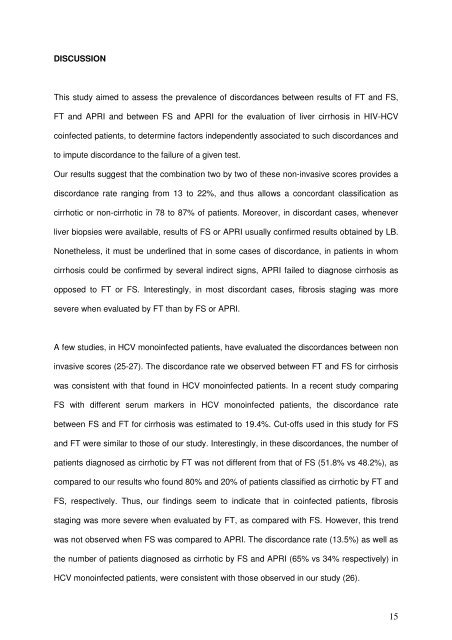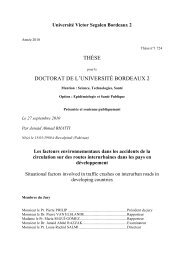You also want an ePaper? Increase the reach of your titles
YUMPU automatically turns print PDFs into web optimized ePapers that Google loves.
DISCUSSION<br />
This study aimed to assess the preva<strong>le</strong>nce of discordances between results of FT and FS,<br />
FT and APRI and between FS and APRI for the evaluation of liver cirrhosis in HIV-HCV<br />
coinfected patients, to determine factors independently associated to such discordances and<br />
to impute discordance to the failure of a given test.<br />
Our results suggest that the combination two by two of these non-invasive scores provides a<br />
discordance rate ranging from 13 to 22%, and thus allows a concordant classification as<br />
cirrhotic or non-cirrhotic in 78 to 87% of patients. Moreover, in discordant cases, whenever<br />
liver biopsies were availab<strong>le</strong>, results of FS or APRI usually confirmed results obtained by LB.<br />
Nonethe<strong>le</strong>ss, it must be underlined that in some cases of discordance, in patients in whom<br />
cirrhosis could be confirmed by several indirect signs, APRI fai<strong>le</strong>d to diagnose cirrhosis as<br />
opposed to FT or FS. Interestingly, in most discordant cases, fibrosis staging was more<br />
severe when evaluated by FT than by FS or APRI.<br />
A few studies, in HCV monoinfected patients, have evaluated the discordances between non<br />
invasive scores (25-27). The discordance rate we observed between FT and FS for cirrhosis<br />
was consistent with that found in HCV monoinfected patients. In a recent study comparing<br />
FS with different serum markers in HCV monoinfected patients, the discordance rate<br />
between FS and FT for cirrhosis was estimated to 19.4%. Cut-offs used in this study for FS<br />
and FT were similar to those of our study. Interestingly, in these discordances, the number of<br />
patients diagnosed as cirrhotic by FT was not different from that of FS (51.8% vs 48.2%), as<br />
compared to our results who found 80% and 20% of patients classified as cirrhotic by FT and<br />
FS, respectively. Thus, our findings seem to indicate that in coinfected patients, fibrosis<br />
staging was more severe when evaluated by FT, as compared with FS. However, this trend<br />
was not observed when FS was compared to APRI. The discordance rate (13.5%) as well as<br />
the number of patients diagnosed as cirrhotic by FS and APRI (65% vs 34% respectively) in<br />
HCV monoinfected patients, were consistent with those observed in our study (26).<br />
15
















